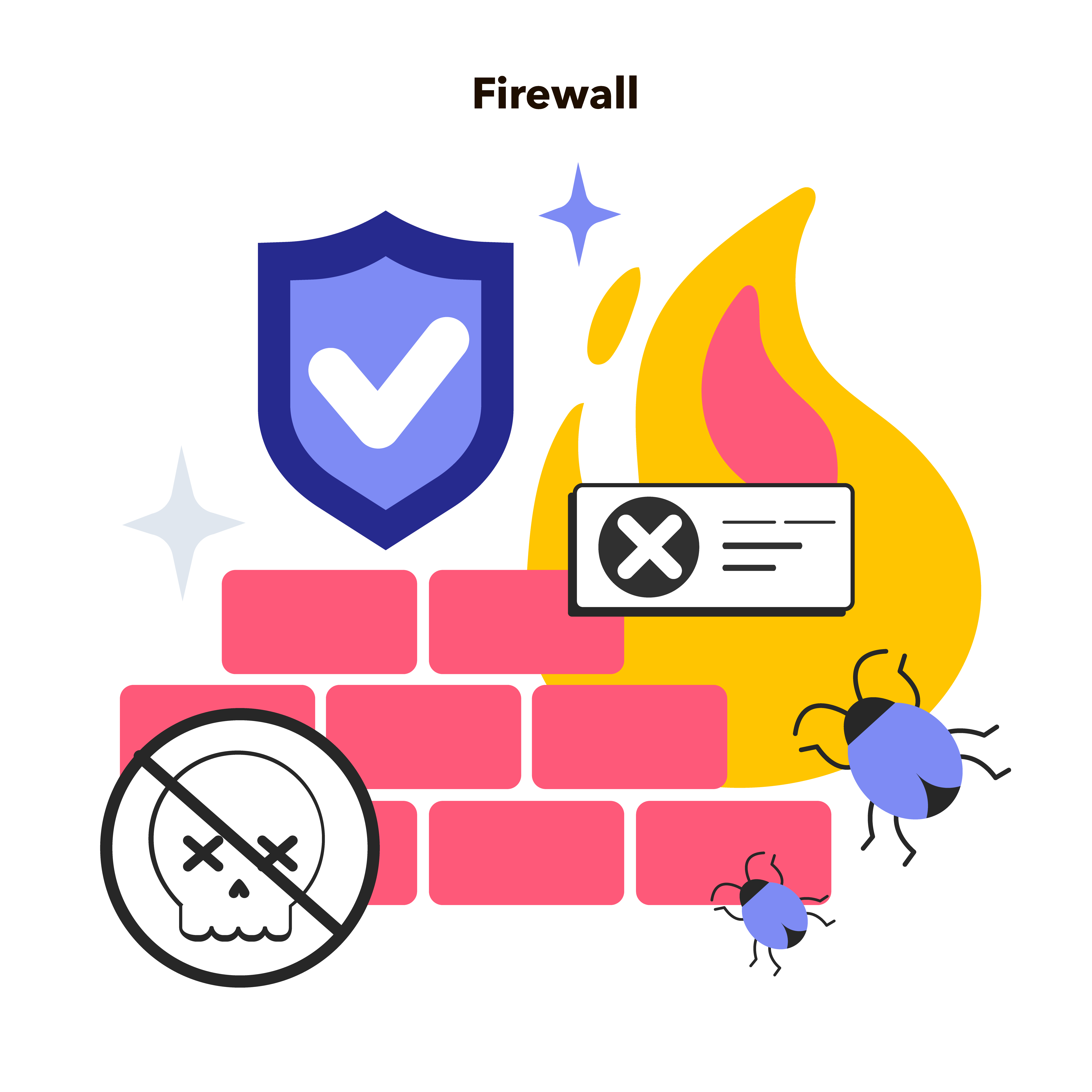
In today’s world, keeping our online activities safe is a top priority for everyone, from parents to office workers. Did you know that firewalls act as robust guards regulating the flow of traffic to and from your network? This article will guide you through the nuts and bolts of choosing firewall options, ensuring your digital life is shielded securely.
Dive in for a clear understanding of how to protect your cyber world effectively!
Understanding Firewalls
Firewalls play a crucial role in protecting networks from cyber threats. They come in two types: hardware and software, each with its own set of advantages and functions. Understanding the differences between the two is essential for choosing the right firewall solution for your network security needs.
Types: Hardware vs Software
Hardware firewalls are essentially physical devices that act as a gatekeeper for your network. They monitor incoming and outgoing network traffic, blocking any suspicious activity.
These durable barriers provide robust protection from external threats by being the first line of defence against cyber attacks. Software firewalls, on the other hand, are installed on individual devices within a network to filter internal system protection, offering specific safeguards for each computer or server.
Deploying hardware solutions often means higher upfront costs but delivers strong data centre protection suited for large-scale environments. In contrast, software options tailor security measures around each application and user need, enabling flexible configurations and easier adjustments in response to evolving cybersecurity concerns.
Whether operating from home or at an office workstation, understanding these differences is crucial in choosing between hardware and software firewall protections for optimal cybersecurity infrastructure.
Purpose and Function
Firewalls, both hardware and software, serve the crucial purpose of protecting your network and devices from unauthorised access and cyber threats. They function as a barrier between your internal network and external networks like the internet, controlling incoming and outgoing traffic based on pre-established security rules.
This ensures that only authorised data packets are allowed to pass through while blocking any suspicious or malicious activity. Additionally, firewalls monitor network traffic for potential security breaches, such as intrusion attempts or malware downloads.
Their primary function is to safeguard your network infrastructure by enforcing access control policies and preventing unauthorised users from gaining entry.
In terms of function, hardware firewalls provide robust security by filtering all incoming and outgoing traffic at the network perimeter level before it reaches computers or other devices.
On the other hand, software firewalls offer similar protection but operate at an individual device level; they secure specific servers or endpoints within a network against potential threats.
Advantages of Hardware Firewalls
Hardware firewalls offer physical protection for your network, providing an added layer of security against external threats. They also allow for customisable settings and are scalable to accommodate the needs of your growing network.
Physical Protection
Physical protection is a key advantage of hardware firewalls, providing a robust barrier between the internal network and external threats. This level of security ensures that unauthorised access attempts and malicious traffic are effectively blocked before reaching the internal network environment.
The physical presence of hardware firewalls adds an additional layer of defence to protect sensitive data and devices from potential cyber-attacks, enhancing overall network security infrastructure.
Furthermore, hardware firewalls offer enhanced protection against threats such as Distributed Denial-of-Service (DDoS) attacks due to their ability to filter incoming traffic at the network perimeter.
Customisable Settings
Transitioning from the benefits of physical protection, it’s important to understand the significance of customisable settings in choosing a firewall solution. Customisable settings allow users to tailor their firewall configurations based on specific network security needs.
This flexibility ensures that businesses and individuals can adapt their firewall settings according to data protection requirements, threat prevention, and network traffic monitoring.
With customisable settings, users gain control over intrusion detection and internal network security, enabling them to effectively safeguard their networks against cyber threats.
Hardware firewalls offer a range of customisation options that cater to different levels of network protection. On the other hand, software firewalls provide user-friendly interfaces for easy configuration and accessibility for adjusting settings as needed.
Scalability
Scalability is a key factor to consider when evaluating firewall options for your network. Hardware firewalls are known for their scalability, making them suitable for larger networks that require more robust security measures.
With hardware firewalls, it’s easier to expand and upgrade as your network grows, ensuring that you can maintain a high level of protection as your business or organisation expands.
This makes them particularly suitable for businesses with plans for future growth and increasing data security needs.
Advantages of Software Firewalls
Software firewalls provide a user-friendly interface, making it easier for non-technical users to understand and manage. They are also accessible across multiple devices, offering protection wherever you go.
User-Friendly Interface
Software firewalls offer a user-friendly interface, making them easier to set up and manage for individuals with varying levels of technical expertise. With intuitive navigation and clear instructions, users can quickly configure the firewall settings to suit their specific security needs without extensive training or support.
This accessibility is especially beneficial for parents or office workers who may not have in-depth knowledge of cyber defence but still want to ensure their network remains secure against potential threats.
Additionally, the customisable nature of software firewalls allows internet users to adapt the settings as needed, providing an additional layer of control over their online safety.
Hardware firewalls also provide user-friendly interfaces that are designed to simplify configuration and management tasks for network administrators. These interfaces often feature straightforward menu structures and easy-to-understand terminology, enabling efficient deployment methods regardless of network size suitability.
Accessibility
Moving from the user-friendly interface to accessibility, it’s important to note that software firewalls have an edge when it comes to ease of access. With intuitive interfaces and straightforward setup processes, software firewalls are easily navigable for parents, office workers, and general internet users.
This means that even those without extensive technical knowledge can take charge of their network security with a software firewall in place.
For office workers juggling multiple tasks or parents trying to ensure online safety for their kids, the accessibility of a software firewall offers peace of mind without the need for extensive training or IT support.
Differences Between Hardware and Software Firewalls

Hardware firewalls are deployed at the network perimeter, providing protection for an entire network, while software firewalls are installed on individual devices to protect against specific threats.
Hardware firewalls offer more robust functionality and configuration options, while software firewalls provide easier accessibility and management.
Deployment
When considering firewall options, deployment methods vary between hardware and software solutions. Hardware firewalls are physical devices that require installation within the network infrastructure.
This may involve dedicated rack space, power connections, and cabling. On the other hand, software firewalls can be deployed on servers or virtual machines to secure cloud environments.
Their installation is more flexible as they do not require physical space or additional power connections.
Understanding these deployment differences is crucial in determining which firewall option best suits your network security needs and infrastructure requirements. It’s important for parents, office workers, and internet users to carefully evaluate these factors before making an informed decision.
Functionality
Hardware firewalls are designed as physical devices, offering robust protection by filtering incoming and outgoing network traffic. They provide a high level of security, making them suitable for businesses with significant security requirements.
On the other hand, software firewalls offer flexibility and can be tailored to meet specific needs. With a user-friendly interface, they allow for easy customisation of settings and are often employed in smaller or less complex network environments.
The functionality of hardware firewalls lies in their ability to protect the entire network at a foundational level, while software firewalls adapt well to varying networking needs due to their customisable nature.
Configuration
Transitioning from understanding the functionality of hardware and software firewalls to configuration, it’s essential to consider network deployment and firewall management. Configuring a hardware firewall involves setting up physical devices, customising settings based on security requirements, and ensuring scalability for future needs.
On the other hand, configuring a software firewall includes user-friendly interfaces that allow for easy customisation of settings and accessibility across various platforms, such as servers or virtual machines in cloud environments.
Both options require careful consideration of network size, management complexity, and updates to choose the right configuration method that best suits specific needs.
Firewall Options: How to Choose the Right Firewall

Considerations for network size, management complexity, and updates and maintenance are crucial factors to consider when choosing between hardware and software firewalls. To find out more about the best firewall solution for your needs, keep reading our blog.
Considerations for Network Size
When choosing a firewall, it is crucial to consider the size of your network. For larger networks with multiple devices and users, a hardware firewall may be more suitable due to its ability to handle higher traffic volumes and provide robust security features.
On the other hand, smaller networks may find software firewalls equally effective in protecting their systems without the need for additional hardware investment. Evaluating your network size will help determine which type of firewall will best meet your specific security needs.
Moving on from evaluating network size, let’s delve into the management complexity involved in maintaining different types of firewalls.
Management Complexity
Managing a hardware firewall can be more complex compared to a software firewall. Hardware firewalls often require specialised IT knowledge and expertise for setup, configuration, and ongoing management.
This complexity can result in additional training needs for the IT team or increased reliance on external support services.
It’s important to carefully evaluate the management requirements of both hardware and software firewalls to ensure that the chosen solution aligns with the available resources and expertise within an organisation.
Updates and Maintenance
Regular updates and maintenance are crucial for keeping both hardware and software firewalls operating at their best. Updates typically include patches or new versions that fix vulnerabilities or improve performance, ensuring that the firewall continues to provide reliable protection against cyber threats.
Maintenance tasks may involve monitoring system logs, checking for unusual activity, and adjusting settings as needed to address emerging security concerns. By staying on top of updates and maintenance, users can help ensure that their firewall remains an effective barrier against unauthorised access and potential data breaches.
It’s important to note that even though hardware firewalls generally require less frequent updates than software firewalls, they still need regular attention to maintain optimal security levels.
Conclusion
Evaluating firewall options is crucial for determining the best solution. Understanding the differences between hardware and software firewalls helps make an informed decision.
Considerations such as network size, management complexity, and updates are essential factors in choosing the right firewall. It’s important to carefully assess the advantages of both hardware and software firewalls to ensure optimal protection for your specific needs.
Ultimately, selecting the most suitable option will help provide robust security for your network environment.
FAQs
1. What are the differences between hardware and software firewall solutions?
Hardware firewalls are physical devices that protect a network from outside threats, whilst software firewalls are applications that guard individual computers against unauthorised access.
2. How do I choose between a hardware or software firewall?
When deciding on the right firewall deployment method, consider your network size, security requirements, and whether you need protection for multiple devices or just one.
3. Can I use both hardware and software firewalls together?
Yes, using both types of firewalls can create an extra layer of security by managing external threats with a hardware solution and internal ones with software.
4. Are there any specific benefits to choosing a hardware firewall over software?
Hardware firewalls often offer higher levels of protection for entire networks and can handle more traffic without slowing down your system compared to most software solutions.
